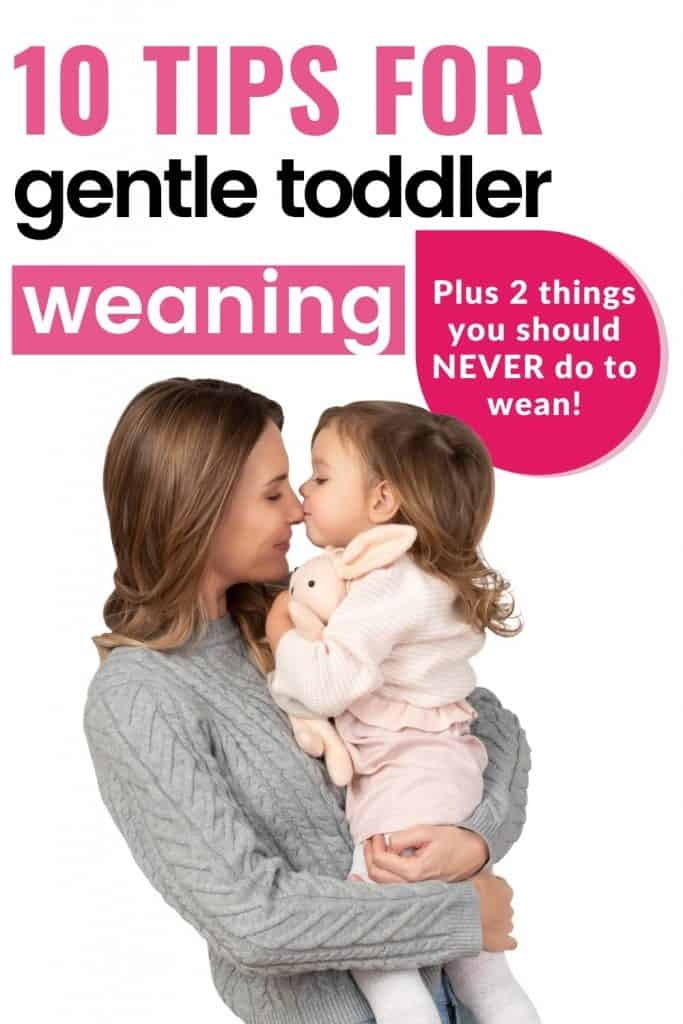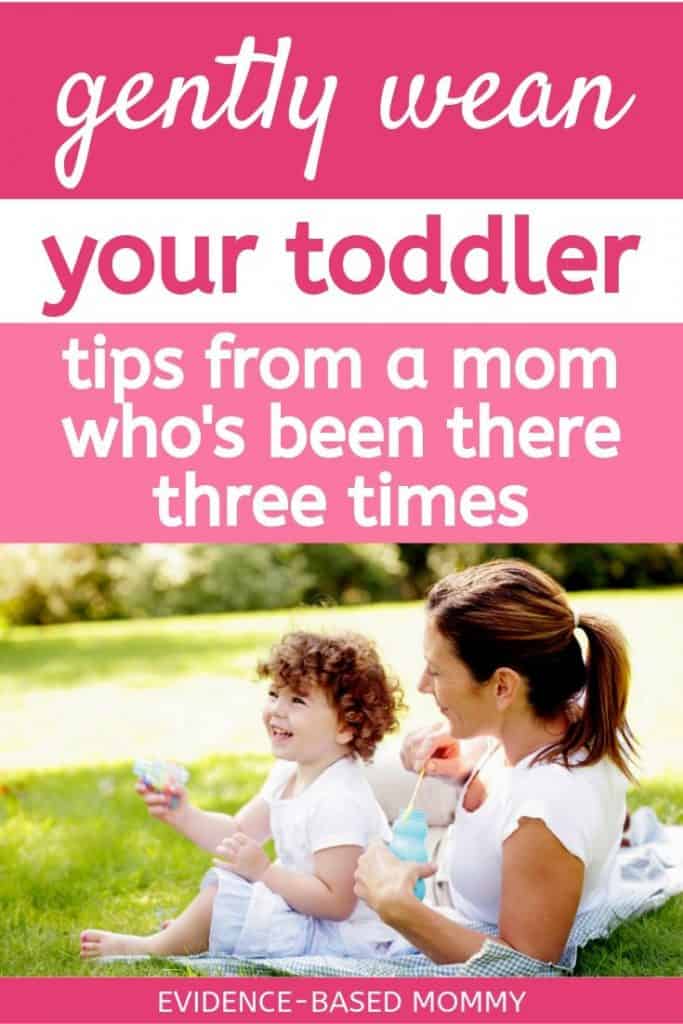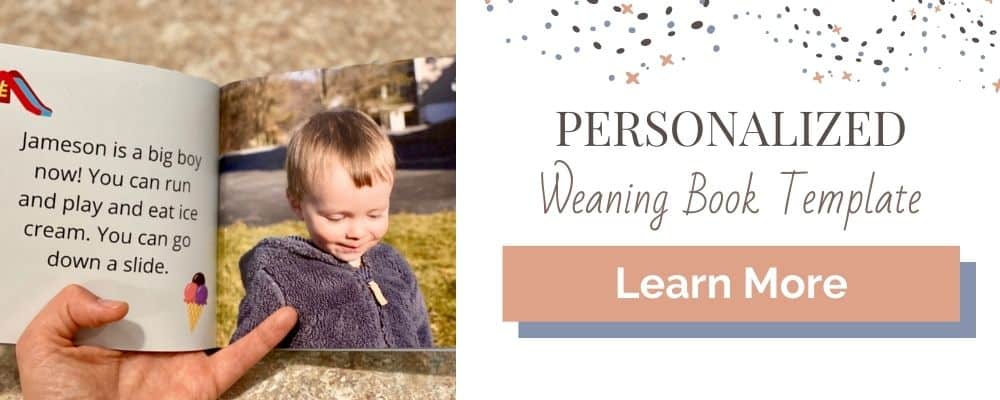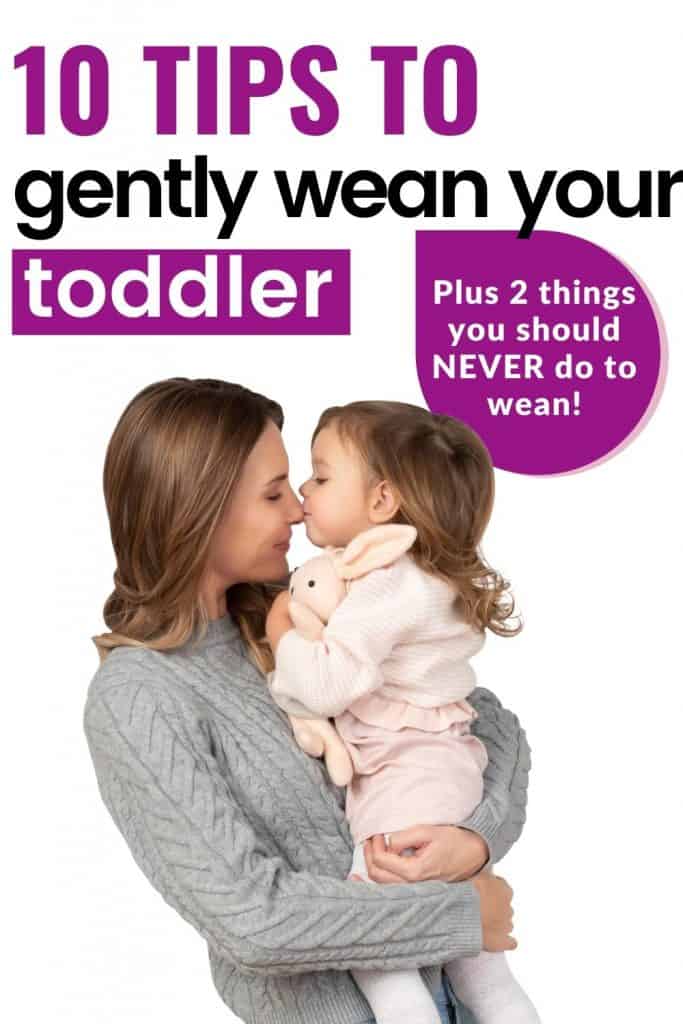If you’ve breastfed your baby to toddlerhood or beyond, congratulations! That’s a huge accomplishment. But eventually, you’re probably going to have questions about gentle toddler weaning.
Will my child ever wean?
How will our relationship change if my toddler weans?
Trust me, I’m a huge breastfeeding advocate. I have breastfed for a solid seven years of my life, and I’ve loved it (well, most of it).
But I think the problem is, we’re so focused on encouraging breastfeeding and supporting women in the beginning of their nursing journey that we somewhat abandon them at the end. There is much less support for weaning, a process that is often full of physical and emotional complexities.

Disclosure: This article contains affiliate links. As an Amazon associate I earn from qualifying purchases. You can read my full policy here.
Plus, we often forget that there is life after weaning, and it is good! You can still enjoy your little one and have a close relationship even after breastfeeding is over.
So let’s talk how to wean your toddler.
Table of Contents
Reasons for toddler weaning
Before we discuss how to gently wean your toddler, let’s talk about why you want to wean.
TIP: Start with books about weaning like this one.
Only you and your child can decide if weaning is right for the two of you. In fact, the World Health Organization recommends that you continue your breastfeeding relationship “for at least two years and as long as mutually desired.“
Full disclosure: Some of what I’m going to talk about below is meant to reassure you that you don’t have to wean for some of the commonly cited reasons. That doesn’t mean that you “can’t” or “shouldn’t,” it just means I don’t want you to feel pressured to wean if you’re not ready yet.

At the same time, if weaning is something you need to do, I’m not judging. Nursing is a two-way street, and if you need to end this time, there’s nothing wrong with weaning. I just want to make sure you know all the facts.
Weaning because of pressure from family or friends
If you live in the United States, it’s likely that many or most people around you aren’t used to children being breastfed past infancy. Americans tend to have unusual (compared to much of the world) opinions about the “normal” length of breastfeeding, and if you go past it (six months, a year, eighteen months, perhaps), people start to question you.
That doesn’t mean you have to wean. You can either try to educate the people pressuring you, or you can simply ignore them. But don’t let them make you feel like you have to stop breastfeeding if you don’t want to.
Weaning because your child is “too old” to nurse
This really isn’t possible. In fact, “extended” breastfeeding (really full-term breastfeeding) can last up anywhere from 2.5-7 years, according to Dr. Katherine Dettwyler, an anthropologist who has extensively studied breastfeeding.

Again, I don’t tell you this to say you must breastfeed your child into kindergarten or that you’re a bad mother if you don’t (of course not!), I’m only telling you so that if you want to nurse past what is the cultural norm in many Western countries, you can feel free to do so.
Weaning to take medication
If you want to continue breastfeeding but are afraid to because you’re starting a new medication, you might still be able to nurse!
I’ve dealt with this exact scenario. I was dealing with severe postpartum anxiety, and my therapist recommended I look into starting medication. I agreed that it was likely the best course of action for me, but I was afraid of passing the drug to my baby. (Being the exposure scientist that I am, I did a lot of research about antidepressants and breastfeeding. Check out this post to learn what I found.)
RELATED: Dealing with postpartum depression and postpartum anxiety
RELATED: Is it safe to take antidepressants while breastfeeding?
Most medications carry a warning to talk to your healthcare provider if you’re breastfeeding, but I suggest something slightly different. Doctors (including pediatricians) are awesome, but they often are not well trained in lactation. That’s just how it is. So often, they’ll just recommend weaning because they’re not sure and would rather be safe than sorry.
Instead, check with a certified lactation consultant. They’ll be better up on which chemicals pass through breastmilk and to what degree.
If you don’t want to (or can’t) find a lactation consultant, the app Lactmed is your next-best resource. Lactmed is a database from the National Institutes of health full of info concerning how drugs are passed through breastmilk and whether these medicines affect milk supply. The app is free (I get nothing from you downloading it, I just recommend it because it’s one of the best breastfeeding resources out there), so install and consult it anytime you have a breastfeeding and medication question.
Weaning because of pregnancy
Often, people automatically assume that they “have to wean” if they get pregnant while breastfeeding! Not so! Breastfeeding while pregnant does not increase risk of miscarriage or early delivery. And it doesn’t “take away” nutrients from the developing baby either.

RELATED: Nursing while pregnant – what you need to know
RELATED: Tandem nursing – Breastfeeding a newborn and toddler
However, breastfeeding while pregnant can increase pregnancy nausea. If your nursling is up all night breastfeeding, it could be impossible to keep up with him due to your fatigue.
RELATED: 6 tips to survive the first trimester of pregnancy
Plus, your nipples may become sore. Especially in the second trimester (remember how it seemed your boobs grew three sizes in one day during your first pregnancy?), you may have breast tenderness, and nursing could hurt.
In these cases, you may choose to wean. If you’re not ready to wean entirely, you could try night weaning or just setting limits to nurse once or twice a day.

Whether or not you’re ready to wean your nursling, you may find she weans on her own. “Lots of toddlers wean in the second trimester because milk supply dwindles. That’s pretty common,” says Alison Keating, R.N., and board certified lactation consultant.
If you are breastfeeding, your milk supply tends to dry up between 16-22 weeks. It’ll be gone for about two weeks, and then you’ll switch over to producing colostrum again (NOTE: If your child is so young that he hasn’t started solids yet, you may have to supplement with donated milk or formula starting somewhere in your second trimester. Talk to your lactation consultant).
If your little one is super attached to nursing, this change won’t deter her. But if she’s growing more ambivalent, it will be easy to wean her. If you want her to continue to nurse, you can encourage it by offering, but otherwise, just take advantage of the natural process and be happy to have an easy weaning!
Weaning because of nursing aversion
Sometimes when nursing a toddler (or less commonly an infant), you’ll start to be annoyed by your child breastfeeding. It’s as if it feels “creepy” for your child to nurse and it makes you want to crawl out of your skin. This sensation is an actual condition (you’re not a bad mom!), and it’s called nursing aversion and agitation (NAA).
RELATED: Nursing aversion (or when breastfeeding isn’t magical
This situation can be really emotionally and mentally difficult for mom and child. When a nursing mother grits her teeth (often literally) and continues to breastfeed through nursing aversion, she may begin to feel resentment towards her nursling.
Many women’s symptoms decrease a LOT with the use of magnesium supplements (either chelated magnesium or magnesium oil that you spray on your skin).
Often, simply setting limits on nursing can help nursing aversion. But if that’s not enough, you may need to wean.
RELATED: 11 ways to set boundaries with nursing toddlers
Unfortunately, I didn’t know about magnesium supplementation when I had aversion with my first daughter. Ultimately, we chose to wean, and looking back, it was absolutely the right decision. I stopped dreading her touch, and our relationship became much better.
Weaning to “get your body back”
I get it! You’ve been breastfeeding for a long time, and you’re just sort of over it.
Like so many decisions in life, it’s a cost/benefit analysis. Extended breastfeeding has great benefits for both mom and child, but if you’re ready to give it up and can find a gentle way to lead your toddler or preschooler towards weaning, that’s okay.
RELATED: Benefits of breastfeeding a toddler
How NOT to wean your toddler
In some ways, weaning a toddler can be difficult because she’s better able than a baby to express her displeasure!

With that said, your child will need support through the weaning process, especially if she’s not on board. There are a few common suggestions for weaning that aren’t respectful and should be avoided.
Vinegar/ bitter taste on your nipple
Some people suggest putting vinegar, something bitter, or even something hot tasting on your nipple. The idea of course is that the toddler won’t like the bad taste and will give up nursing.
While this may work, it can backfire. First of all, you might discover that your child is a fan of Tabasco and has no problem with your nipple tasting like it!
But beyond that, it just sort of sucks for your child’s last experience with one of her favorite things to be so negative. While this method may remove some of the conflict often associated with weaning, it just doesn’t feel very respectful.
Leaving on a long trip
Another commonly suggested weaning method is to go on a trip without your child for several days. Ideally, you come back, your child has forgotten all about “the milkies,” and you’ve dried up anyways.
But again, this is not a responsive, loving way to wean your child. Likely, your little one is very attached to nursing. Your breasts are very comforting to him. If you just leave while weaning, he doesn’t have his mother through this possibly stressful experience.
In addition, if your breasts are used to being emptied multiple times a day and you suddenly just stop nursing, you’re likely to deal with complications like clogged ducts or mastitis!
Quite frankly, this method may just not work. I’ve been away for work trips that last several days (I would bring a hand pump with me), and when I came back my little boy would always jump in my lap and pull up my shirt. Clearly, nursing had been on his mind even when I was gone!
How to gently wean your toddler
Fortunately, there are much better, gentle weaning methods out there. While there may be some crying (or maybe you can wean without tears, who knows!), you’ll feel good knowing you supported your child every step of the way.
Natural term breastfeeding
The easiest way to wean (at least for your little one) is natural term breastfeeding, or simply continuing to breastfeed until your child is ready to stop. This method can be a huge (but rewarding) commitment, often lasting anywhere between 2.5-7 years.
Some children seem to keep nursing as long as possible, while others just lose interest. I’ve heard of children asking their mother if they can make chocolate milk or juice from their breasts, and when she says no, they just decide breastfeeding isn’t worth it anymore.
If this happens with your child, you may be surprised, sad, and even hurt! That’s totally understandable. A lot of times, they’re ready to grow up before we’re ready for them to. But make sure not to take those feelings out on your little one. Make sure you still offer cuddles and over ways to show affection, and save your hurt feelings to share with your partner or a supportive friend.
But often, natural-term weaning is a more gradual process.

My current youngest (2.5) seems to be self-weaning right now. He goes a few days without even asking to nurse. When he does ask, he usually feeds for 30 seconds or less. It’s like he’s just checking in.
This morning, Budrow asked to nurse for the first time in at least two days. I simply told him no, “the na-nas hurt” (I’m pregnant with our fourth and this is totally true), so he toddled off without any fight, ready to go play instead.
UPDATE: Soon after I wrote this post, my son stopped weaning. I was grateful to have one child who decided to self wean, even if I was also a little sad.
If you have a much older nursling (say, a kindergartner), he may eventually lose the ability to latch correctly. He simply won’t be able to nurse anymore (this often coincides with the first permanent tooth erupting). It may be somewhat sad for both of you, but you can also be proud that you kept such a special part of your relationship going for so long.
Don’t offer, don’t refuse
One weaning trick you’ll often hear is “Don’t offer, don’t refuse.” For example, if I wanted to, I could probably make sure Budrow keeps nursing. If I asked him if he wanted na-na while we were cuddling in the morning, he’d probably be all about it. But since I don’t say anything, he gets up within a few minutes, happy to go drive a matchbox car around the floor.
A related weaning tip: Try not to be around your child shirtless or in something low-cut while weaning. Out of sight, out of mind.
Gentle weaning before your little one wants to
There are times when you want or need to wean before your little one is ready. That’s okay. As long as you approach weaning gently, it can still be a successful transition for both of you. Here are several strategies you can use to implement weaning in this case.
Read books about weaning to prepare your toddler
Before you start the weaning process, it helps to introduce your toddler to the idea of what weaning is, and that yes, it is possible to go through life without nursing.
An excellent way to do this is through weaning books! Both of these sweet books are written specifically to help your little one understand what weaning is and what the process will be like.
RELATED: Personalized Toddler Weaning books

Even better? A personalized weaning book written about your little guy or girl.

I’ve created a weaning book template where you can add pictures of your little one and put their name in it. Simply print it out and then read it to your child. Click here for more details.
Wear shirts/dresses with a high neckline
When you’re trying to wean, you don’t want to remind your child of the goods. So during weaning (and even for a few months afterwards), try to wear shirts that fully cover your breasts when you’re around your toddler. Out of sight, out of mind.
Don’t sit in the usual nursing spot
Do you often cuddle up in a particular recliner to nurse? Avoid that chair when you don’t feel like breastfeeding. Your child associates that place with mama milk, so they’re going to expect access when you’re there. Help them not think about nursing by staying somewhere else.
Cut down the number of nursing sessions
Start decreasing the number of nursing sessions instead of going cold turkey. Before naptime and bedtime are popular choices.
You’ll want to remind your child what the expectations are. “We’re not getting nursies right now. We get nursies at naptime.”
Distract your child
Have some fun activities planned for when your child asks to nurse (these are really helpful). You can simply say, “No nursies right now. Do you want to play with your doll?”

Hopefully, your child is so excited to play that they forget all about nursing (at least for a little while).
You can also set up a new area for them, such as a “calm-down corner” that they can use when they feel overwhelmed. This is a great alternative to nursing to help with big feelings.
RELATED: Creating a calm down corner for kids
Go outside
Going for walks or playdates in the park, or even just in the backyard, is a great way to give your child something to do besides nursing.
Set a “no more nursies” date
You don’t want to just spring on your child that they can’t nurse anymore. Instead, you need to help them know what’s coming.
For my oldest daughter, we set a “no more na-na” date. On Friday, we told her that in three days, we would be all done with na-na. We continued to explain and keep up with the countdown every day.
On Sunday night, we explained to little Leia that she was getting her last na-na. In the morning, she would be all done with na-na, and at the end of the week we would celebrate. Of course, I’m not sure how much she really understood, but we tried.
Give your toddler the power to decide when she is done nursing
With my second child, we did things a little differently. Instead of setting a date, we told her that she could “get three more na-nas.” Over the next couple of days, when she nursed, we counted down and explained how many nursing sessions she had left. We were really clear when it came time for her last breastfeed, and explained that we would celebrate at the end of the week.

Have a weaning party
Whether you’ve heard of them or not weaning parties have been happening for a long time. In fact, there’s a weaning party recorded in Genesis. Let’s keep this fun tradition going.
For your party, celebrate your child becoming a “big” boy or girl! For us, we took our kids to the zoo about a week after weaning. We also celebrated with a little weaning party at home and a weaning cake.

Make sure you emphasize how proud your child must be of himself (be less vocal about your own pride at his accomplishment).
And if you’re struggling, that’s normal. Weaning a toddler is the end of a very important part of your life too. Definitely deal with those emotions, but try to keep all your feels to yourself and other adults in your life and not put them on your little one.
How long does it take to wean a toddler?
Honestly, it depends. If your child is ready (like my third was), just a few weeks of gentle redirection may be enough to wean your child. But if your toddler doesn’t want to wean yet, there may be a month or two of big feelings if you stop abruptly.
Again, giving your child lots of warning and slowly reducing feeds is best.
How does weaning affect the mother?
Weaning is a relationship between both you and your child, and it absolutely can have an effect on you too. Of course, you may have your own feelings about your child growing up, and that can be upsetting for you.
Not only are there the natural feelings of sadness about your breastfeeding relationship ending, but weaning (especially sudden weaning) can cause major hormonal upheaval as prolactin decreases and estrogen increases. This can cause mood swings, irritability, anxiety, or sadness.
In addition, abrupt weaning can lead to risks of mastitis or clogged ducts. So be sure to take care of yourself during this transition.
Complications after toddler weaning
Weaning is a big accomplishment for both of you! But you’ll probably encounter new challenges after weaning. Make sure you prepare.
New ways of handling problems
One of the magical things about breastfeeding is how it can cure anything for a toddler or preschooler. Hurt feelings, scraped knee, exhaustion… all of those things can be handled by nursing.
So when you have to deal with one of these problems and you suddenly don’t have breastfeeding in your arsenal, parenting becomes a little more difficult. You’ll need to learn new emotional regulation skills and teach them to your child.
RELATED: 5 mindfulness activities for toddlers

One great solution is the Mindful Mamas and Connected Kids toolkit. When you get this resource, you’ll receive eight pages of strategies to implement immediately, including the six step Tantrum Tamer Process (who doesn’t need that with toddlers?), Mama Mantras to help you keep your cool, and Playful Prompts for Cooperative Kids. Sign up for your copy today.
Clogged ducts / mastitis
Especially if you wean suddenly, you have a chance of developing a clogged duct or even mastitis. Unfortunately, the best cure for both is breastfeeding to remove the clog, but if you’re weaning that’s counterproductive.
RELATED: Engorgement relief for breastfeeding
To prevent clogged ducts, have a pump on hand and pump just enough to relieve pressure (not enough to empty the breast, which encourages milk production). Make sure to use pressure to press milk out of any particularly tight spots. Another great option is to hand express in the shower (the hot water really helps you get milk out).
If you end up with mastitis, you’ll be hit with flu-like symptoms. Go to the doctor, where you’ll likely be prescribed antibiotics. You’ll need to rest and take it easy for a few days.
Weaning depression / anxiety
Finally, weaning will cause a change in hormone levels. Both prolactin and oxytocin will drop, and these changes can cause depression, moodiness, anxiety, or irritability.
On top of that, you’re dealing with a major transition that you may already feel a little sad about, so things may be even harder.
Just be aware of these symptoms, and if they last for more than a few weeks, go see a therapist.
Conclusions on gentle toddler weaning
No matter what your situation is, weaning your toddler is a big change for both of you. But with a little preparation, you can make it work and move on to the next stage of your relationship.
If you want a special memento of your time nursing, and a great way to give your child confidence that he can wean, make sure you check out my Personalized Weaning Book Template.





Thank you! I’ve been trying to wean my 3 year old for a while and nothing has worked yet.
You can do it. Good luck!
Thank you for this article. It’s definitely given me food for thought. I’m considering night weaning my almost 15m daughter-never expected to make it this far really! Some days, she goes the whole day without nursing but she feeds frequently at night. I’m concerned she is still getting nutrition from it and stuck in a bit of a reverse cycle. Even though she does associate feeding with going to sleep, 97% of the time she unlatches before going to sleep because she loves sucking her fingers, and she always drinks efficiently then tends to go back to sleep quickly during the night (if she feeds at all).
I have a lot of travel to do at the end of October, and bringing her with me would be tricky, which is why I’m considering trying to start reducing feeds now. She screams murder if my husband tries to console her at night, even if she doesn’t want milk from me, just a quick Mami cuddle back to sleep. I wonder if I should focus on her getting used to Dadi being around during the night first, before reducing any feeds. I also think there may be something else keeping her up rather than just wanting milk – lots of whining, tossing and turning…
Anyway, sorry for the essay! Just really liked some of your ideas ????
I’m glad it helps! Yeah, maybe try and see how it goes before October? You can always back try again later if it doesn’t work now. Good luck and keep me updated.
Been trying to wean my two year old but we are struggling. I’m pregnant (22wks) and it’s literally makes my skin crawl. He only nurses at bedtime and nap time but it’s a huge fight if I don’t nurse him. He doesn’t sleep well and never has been a good sleeper and now I think he has more teeth coming in. I need a break before this next baby comes.
Hi Megan, I’m so sorry this is happening for you! It sounds like you’re dealing with nursing aversion – check out this post for more resources on it.
I’ve also got a post about nursing through pregnancy.
Maybe try night weaning? I found my aversion was better when I wasn’t as exhausted.
I know this isn’t easy. You’ve got this, and let me know how I can help.